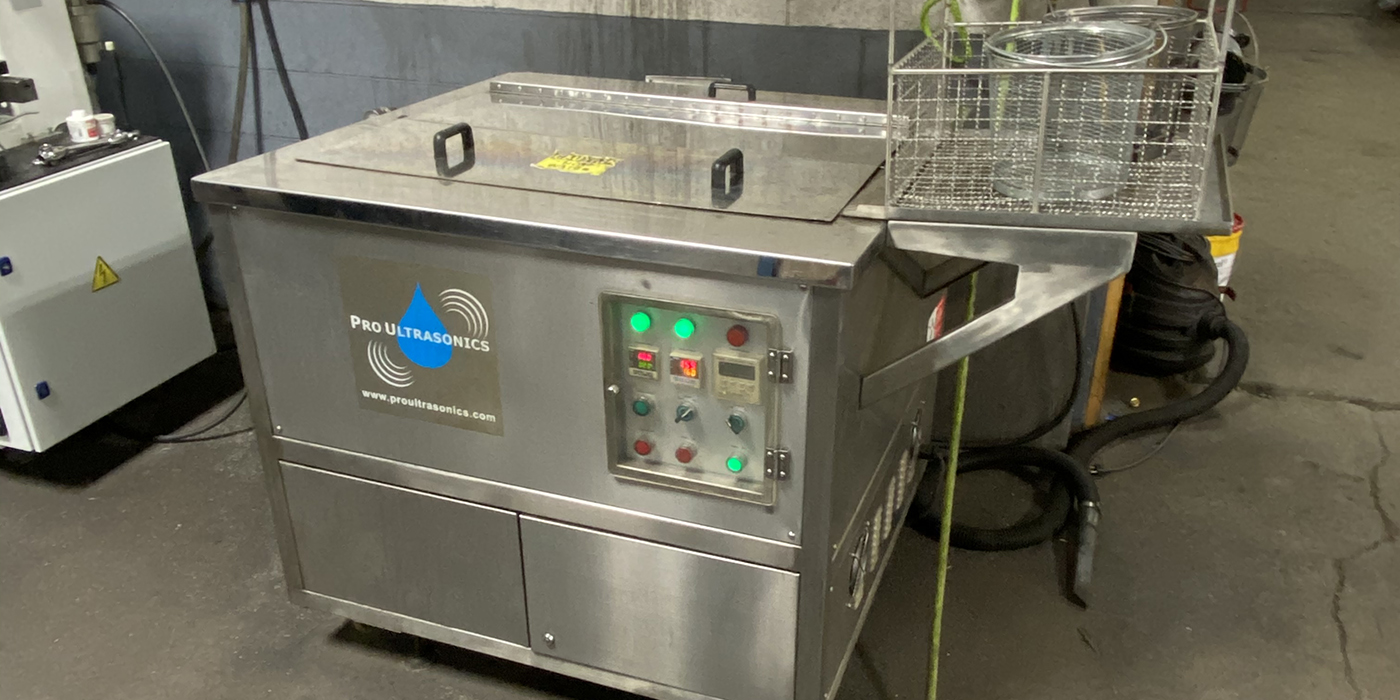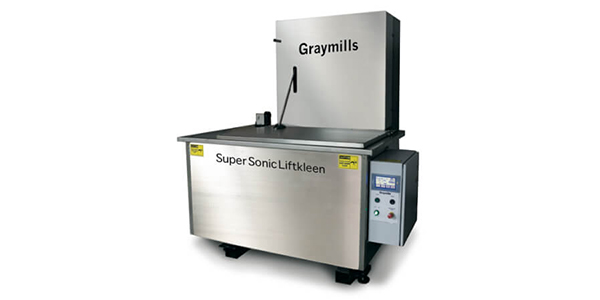
Here’s the kicker – those shops who feel that proper cleaning is too difficult, too time consuming or too expensive are actually leaving money on table when it comes to their engine parts.
“At one point in my career, cleaning seemed like it was really difficult,” says Dave Arce of Arce Enterprises, El Cajon, CA. “It’s still a big process but the equipment and chemicals that are available have made it a lot easier today. I still believe it’s one of the most critical steps of an engine rebuild, though. Difficult yes, but very important.”
Arce admits that other steps – machining and assembly, for example – are relatively easy compared to cleaning. But, neglect the beginning of the build and everything else is exponentially harder.
“If you don’t have the front end information that comes from the disassembly and cleaning operations, you’re going to be in trouble,” Arce says. “Especially when you’re doing such a wide range of engines as today’s typical CER. If you don’t keep track of everything on the teardown process, you’ll be struggling on the reassembly side.”
To ensure the last part of the rebuild goes as smoothly as possible, Arce says he keeps two very important things in the teardown area: a digital camera and an experienced technician.
“It seems like many shops have relegated disassembly to the least experienced member of the team,” Arce says, believing that’s exactly the opposite attitude a progressive shop should have. “If you can put an experienced guy on the front end, who understands how it all comes apart, I guarantee that when it gets to the engine room and you go to reassemble it, that guy will be very helpful when there are questions.
“In addition, we pride ourselves on putting everything back the same way it came off, and you can make it easier on the front end by having your experienced man take pictures as the engine is torn down. Whether it’s an eccentric, a dowel pin or anything else, it can save you hours of research when it comes to putting it all back together,” Arce says.
Randy Bauer, Gas Engine Division manager for Jasper Engines & Transmission, Jasper, IN, says the decision whether to salvage engine parts during the remanufacturing process always starts with the quality. “We do not want to put a bad part into an engine where it is subject to fail,” Bauer says. “However, secondarily, cost is an issue, of course. In most cases, we’re spending more time trying to figure out how we can better clean and better reman product because the new parts are not cheaper. That’s where we get our parts cost savings which we can pass onto our customers.”
“Prepping and cleaning parts is a very important part of the remanufacturing process,” says Bauer, “but they’re not the final step.”
On a standard rebuild, Arce says his shop salvages the block, heads, crankshaft, camshafts and connecting rods as a matter of course. In addition, if possible, he’ll salvage valves, rocker arms, springs and pushrods as well as any accessory brackets, hardware and fasteners. “There are a wide variety of cleaning techniques we could employ,” Arce says. “In our location we have decided that a liquid-based cleaning regimen works best for our needs.”
Cleaning cast iron and aluminum, for the most part, represent two separate challenges. Some shops have more than one type of cleaning system and therefore can take advantage of the best attributes of each. It’s accurate to say that there is not one perfect system. Each system offers benefits but may also leave some things to be desired in the end result if used on its own.
When using a hot tank or a jet spray washer the appropriate chemical must be selected for the type of metal.There are a variety of chemicals available from different chemical manufacturers, and those manufacturers should be consulted about the right solution for your shop’s needs.
Some are designed for cast iron only – these are likely to be much more aggressive cleaners. Others, designed for aluminum, offer a high pH level with some type of caustic to cut through the oxidation layer and using an inhibitor to protect the aluminum surface after it has been cleaned. If you clean a variety of engine parts, then a solution designed for one type of metal will be unlikely to meet your needs, although dual-purpose chemicals are available that can clean cast iron reasonably well and aluminum very well.
In addition to choosing the right chemical for the job, engine builders must use the proper temperature setting on their spray washer or hot tank and to maintain the right concentration of chemical as well. You want it strong enough, yet not too strong.
Arce says he has experimented with other methods – ultrasonics, for example. While he’s generally impressed with the technology’s effectiveness, he hasn’t pulled the trigger on buying a unit for his engine building operation. “We have a small ultrasonic unit for cleaning and rebuilding our gas injectors,” he says, giving the impression that a larger unit for bigger parts might be a good thing in ecologically restrictive California.
In fact, in the annual Machine Shop Market Profile (questionnaires are currently being tabulated by Babcox Media for this year’s report), ultrasonic cleaning equipment usually ranks as one of the top two or three items on our respondents’ “wish list” for the upcoming business year.
Ultrasonic cleaning is the process of creating tiny bubbles on the surface of the part, which then act as scrubbing agents to pull dirt particles away from the component surface. Like other aqueous systems, ultrasonic systems use a chemical solution to help get the part clean.
The bubbles create a cavitation effect that can reach virtually every area of the component that is exposed to chemical solution. Anywhere water can reach, it can clean. If you are cleaning both aluminum and cast iron you will have to use a chemical that is safe for both. The chemical you use may be the same as for the jet spray washer, however experts say that concentration levels can be much lower with an ultrasonic system.
Engine builders we have spoken to who use these systems say they are also very fast, cleaning many components in 10 to 20 minutes, and they work extremely well on galleys and blind passageways.
Bauer says remanufacturers and rebuilders salvage parts for a variety of reasons, but like Arce, he focuses on parts that can be cleaned and reused for a reasonable cost with verifiable quality. Whether they’re aluminum, cast iron or steel or some other composite, there is a cleaning system capable of restoring parts to their like new appearance.
This doesn’t mean there’s one system capable of doing it all. Jasper breaks down the cleaning process according to metallurgy.
“With small steel or cast iron parts, including crankshafts, cams and connecting rods, we run them through a three-step process that includes a degreaser in a chemical tank, then a derust solution, followed by an anti-rust solution. Once the parts have gone into their three separate baths everything gets inspected.
Today’s modern rust removing solutions are very interesting works of science. According to experts, while location and season may offer some relief, there’s really no environment in the United States that is immune to rust.
The non-toxic, pH-neutral solutions actually absorb rust from the iron through a process called “selective chelation.”?The solution’s active ingredient bonds to iron, and can remove iron from the rust but is too weak to remove iron from steel where the iron is held much more strongly. Once the chelating agent has removed the iron, a sulfur bearing organic molecule pulls the iron away from the chelator and forms a ferric sulfate complex, which remains water soluble. This frees the chelating agent to remove more iron from rust.
“We have aluminum or composite small parts, as well as aluminum cylinder heads, and occasionally, blocks, that process parts through a presoak tank that is filled with a degreasing chemical. We may use agitation or ultrasonics (or a combination of both) before the parts go into a rotating pressure spray cabinet,” Bauer explains. “This water-based spray cabinet cleans with high pressure.”
From there, Bauer explains, parts go into a manual blasting cabinet.?“We physically blast the parts with plastic or baking soda media, depending on the type of part it is. After that, the parts go back into a agitating cleaner with a mild detergent solution for a final wash off.”
Baking soda is relatively soft, inexpensive and is water soluble (which distinguishes it from other soft media such as plastic beads or walnut shells), and can also be used for dry or wet blasting.
When baking soda (or other media) is mixed with water it forms a slurry, which can be a very effective wet blasting method. Wet blasting, as a closed-loop process, eliminates the dust and can reduce the amount of product used, according to a manufacturer of this equipment. By filtering and recirculating the media, baking soda can be reused 5 to 6 times before it breaks down and goes out of filtration.
For the big cast iron castings, predominantly, cylinder heads and engine blocks, Bauer says Jasper uses a bake and blast cleaning procedure. “Dirty, oily disassembled core parts are baked overnight at 800 degrees for 12 hours.The next day we put them in an automated steel shot blasting cabinet,” Bauer explains. “The parts are put it into a barrel tumbler to get the steel shot back out, then put it into a final wash with a mild detergent.”
As Bauer explained earlier, he says some parts aren’t reclaimed because it’s cheaper to buy them new. However, whatever method of cleaning is employed, the next step is inspection and repair.
“The five major component castings – head, blocks, cranks, rods and cams – are never simply cleaned and reused. They all require some form of machining after cleaning to get them to our specifications,” he says. “It may be a head that needs the valve seats replaced or recut, or the deck being resurfaced, we expect all of our parts will need some additional work.”
Bauer says he believes his current cleaning systems are very capable of meeting Jasper’s needs, but that doesn’t stop him from researching new options. We’re always looking at tradeshows, visiting other PERs and talking to manufacturers,” he says. “Our eyes are always open for a better way to make cleaning better and faster so that it all rolls back into our cost savings.”
Cleaning Equipment & Services Suppliers:
[inpost_gallery thumb_width=”200″ thumb_height=”200″ id=”” random=”0″ group=”1″ border=”” thumb_margin_left=”3″ thumb_margin_bottom=”0″ thumb_border_radius=”2″ thumb_shadow=”0 1px 4px rgba(0, 0, 0, 0.2)” js_play_delay=”3000″ post_id=”3351″ type=”yoxview” sc_id=”sc1389907289939″]
Aerolyte Systems
Washington, MO 63090
636-239-8130
Anchor Atlantic Group LLC
Pitman, NJ 08071
800-458-0355
Armakleen Co.
Princeton, NJ 08543
800-332-5424
Blackstone NEY Ultrasonics
Jamestown, NY 14701
800-766-6606
Clemco Industries Corp.
Washington, MO 63090
636-239-8130
Dakota Ultrasonics
Scotts Valley, CA 95066
831-465-8585
Graymills Corp.
Chicago, IL 60613
773-477-4100
Harris Labs/Evaporust
Springdale, AR 72764
888-329-9877
Ketecta USA
Phoenix, AZ 85027
602-278-7789
Kolene Corp.
Detroit, MI 48223
800-521-4182
www.kolene.com
LS Industries
Wichita, KS 67214
800-533-8008
Mart Corporation
Maryland Hts., MO 63043
314-567-7222
Mirachem Corp
Phoenix, AZ 85063
800-47-3527
Miraclean Corporation
Ashville, NY 14710
716-763-4343
Omegasonics
Simi Valley, CA 93065
805-583-0875
Pro Ultrasonics
Racho Cucamonga, CA 91730
909-397-4118
Sardello Inc.
Aliquippa, PA 15001
724-375-4101
Simple Green
Huntington Harbour, CA 92649
800-228-0709
Soda Blast Systems
Houston, TX 77048
800-216-7632
Ultrasonic Power Corporation
Freeport, IL 60132
800-575-0168
Viking Blast & Wash
Wichita, KS 67226
316-634-6699
Wet Technologies
Holbrook, NY 11741
631-285-7285
Winona Van Norman
Wichita, KS 67214
800-533-8008
Workshop Hero
Howell, MI
517-546-1117
Zero Blast Cabinets
Washington, MO 63090
636-239-8130
Zerust
Circle Pines, MN 55014
763-225-6600













